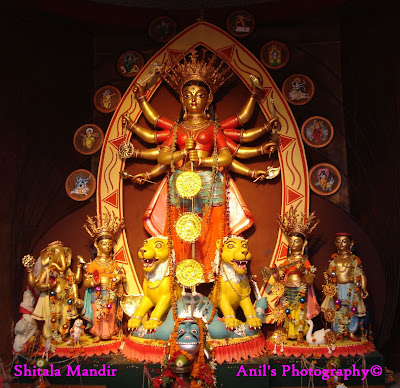 |
Two young tribal girls (Santal Ramani) and a boy. Scupture by Ramkinkar Baij. His large compositions in cement on the simple lives of the Santals, placed in the campus, are the great contributions to the heritage of Indian sculpture. |
Santiniketan is a small town near Bolpur in the district of Birbhum of West Bengal, India, and its distance from kolkata is about 180 KM.Once upon a time today’s Shantiniketan was known as Bhuban Danga, which was the den of a local dacoit named Bhuban Dakat. “Danga” means a vast unfertile plane land. The land was owned by the Tagore family. Rabindranath Tagore’s father, Maharshi Debendranath Tagore, renamed it as Shantiniketan, which means abode (niketan) of peace (shanti).
 |
| Campus |
Rabindranath Tagore started an open air school there for children named as “Path Bhavan”. Tagore’s idea was that of learning in a natural environment, in the open, under the trees, would be more closer to nature. Classes in the open still in vogue there.
Open air class- still in vogue
After Tagore received the Nobel Prize in 1913 for literature (for the book Gitanjali), the school was expanded into an university named as Visva Bharati. Today Visva Bharati is one of the renowned universities, which attracts thousands of students each year. Visva Bharati's symbolic meaning being defined by Tagore as "where the world makes a home in a nest". The aim of this educational institute was the quest for truth, blending the methods of learning of the East and West. Visva Bharati, now more than a hundred years old, is one of the most prestigious universities of India with degree courses in humanities, social science, science, fine arts, music, performing arts, education, agricultural science and rural reconstruction.
 |
| Rabindra Bhawan (Also called Bichitraa). It is the museum where Tagore's paintings, Nobel medallion and his used items are displayed here. |
 |
| Kala Bhawan |
 |
| Murals on the wall of Kala Bhawan (art College) |
Kala Bhavana, the art college of Santiniketan, is still considered one of the best art colleges in the world.
 |
| Kala Bhawan students during off period |
Prime minister of India Smt. Indira Gandhi, renowned film director Satyajit Ray and Nobel Laureate Amartya Sen were among its most illustrious students.
"I consider the three years I spent in Shantiniketan as the most fruitful of my life ... Shantiniketan opened my eyes for the first time to the splendors of Indian and Far Eastern art. Until then I was completely under the sway of Western art, music and literature. Shantiniketan made me the combined product of East and West that I am."
[-Satyajit Ray, as quoted by Amartya Sen in The Argumentative Indian, pp. 115, Penguin 2005]
The most prestigious possession of Shantiniketan, the pride of the nation, the “Nobel Prize” medallion of Kabiguru Rabindranath Tagore which was in display in the ‘Rabindra Bhavan’ (Museum) till it was stolen in the beginning of 2006 and till today it is untraceable, even CBI has failed to trace it.
Shantiniketan is also a tourist attraction today because Rabindranath wrote many of his literary classics here.
Major Events which attracts tourist to the campus: Numerous social and cultural events takes place through out the year which are part and parcel of Santiniketan. These are Basanta Utsav, Poush Mela , Rabindra Jayanti to name a few. But the place can be visited without any event just in tany weekend and one fine morning two years back, we did the same thing and we reached Shantiniketan by morning train. We hired a Maruti van and took the local sight seeing and we visited Khowaier haat, Deer park, kankhali tala, Amar Kutir, Rabindra bhawan (Museum) and villages attached to shantiniketan campus. Next day we visited the Sangeet Bhawan, Kala Bhawan, Uttarayan, The Sculptures of Ramkinkar Baij, kala Bhawan Hostel where Nanda Lal Bose, Ramkinkar baij and other prominent artists lived once.
 |
| Khowai Saturday Market ( Saturday Haat)শনিবারের খোয়াইয়ের হাট |
Note from the author : This article has been transferred from my another Blog. Two years back it was posted there when this blog was not in existence. Now I thought this is the right place for the article to be posted.




















































